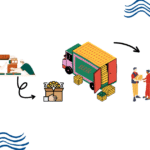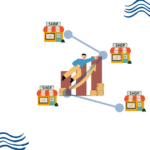- Payel Adhikary Ghosh
- 0 Comments
- 1285 Views
When we talk about the purpose of using a field sales management tool, one of the major reasons is we want to have a complete visualization of how our sales strategy is led through the field sales team. For the very same reason, we prefer having a real time location view on the google map of our field sales agent’s whereabouts. Thematic map provides us with a deeper visualization on showing the geographical pattern based on a particular theme or use case such as- density of your product in a certain region, the outlet coverage completed by your field sales agents.
In this article read to get thematic map information. We will make you understand why it is important and how you can leverage it for your next sales strategy.
Thematic Map Definition
If we talk about thematic maps, then thematic mapping is such a great concept that helps us visualize spatial data in such a way it displays particular themes or distinct patterns of the data. On the other hand, thematic maps do not show geographical elements such as rivers and mountains. instead they are used to visualize data according to a specific subject or characteristic.
These can be simple, like choropleth maps that color in regions or districts according to values of interest, or they can be more complex scatter plots with dots representing individual points along an x and y axis. Authorities can analyze useful relationships that exist among their data by employing thematic mapping tools.
Thematic map okay so basically thematic you should understand what different symbols, colors and patterns in the map we use to represent anything on the map like that. Simply put, creating visual representations of raw data that can be quickly and clearly understood. Thematic maps are important tools for urban planning, environmental science and market analysis among other fields of study since they enable the interested parties to make rational decisions on spatial patterns and distribution.
Decoding Product Density in the FMCG Industry through Thematic Maps.
Thematic map can be quite a tool for the FMCG sector because it can be quite insightful to know where your product is going out like hot-cakes. These maps allow you to visualize where your product is selling and how well it’s performing in those locations. With thematic maps, uncovering product density insight is fairly simple with multiple types of maps you can use.
Types of Distributional Maps
There are many types of thematic maps, here we have explain the uses and types of distributional maps:
Choropleth Maps
Choropleth Maps are used to analyze the product density of a particular geographical region. In these images, colors or shades show the varying sales and availability of either products in different regions.
For example, you want to have a quick glance on the regions where your new snack is selling swiftly . Using a choropleth map, we can quickly show this information represented by sales per zip code and darker colors indicating more sold. So it’s easy for you to see what areas currently love your product, and which might need a bit more marketing effort.
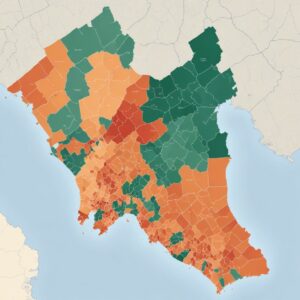
Dot Density Maps
To differentiate a bit, dot density maps use dots to represent a certain number of product units sold. The more dots in an area of the map, the denser the product offering. This kind of map is very useful for finding clusters or patterns that may otherwise go unnoticed in other types of maps. You were looking at a dot density map and all of a sudden you see that there’s 20 dots on top of one particular supermarket — jackpot, your product is flying off the shelves from this store.
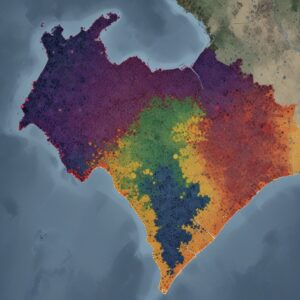
Heat Maps
Heat maps are colored in such a way that warmer colors like red and orange represent higher densities of product than the cool-colored blue (and other shades). It generates an homogeneous picture of the distribution of a product and sometimes can be easier to understand than dividing our data in regions as it’s done in choropleth maps. Heat maps are really great ways to quickly understand where your product is working well.
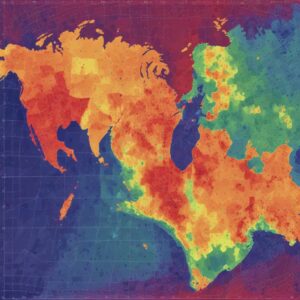
Combining each of the maps with one another
Where thematic maps really shine is when you take multiple in combination with other data layers. A product density map might be an overlay of demographic data such a population or income levels to give insight into which markets may have not only a high demand for your product, but the available funds to spend on said service, etc.
Alternatively, you might incorporate data about distribution centers and transportation routes to further analyze their effects on product availability and sales. Overall, this rather comprehensive picture can be used as an instrument for making decisions on marketing and logistics.
Why Use Thematic Maps?
Visualize the product density in a map for FMCG companies to make more informed calls on where they should be selling, where they should advertise and which markets have potential. Cartographic production of thematic maps that illustrate special distinction of the product implementation and demand. The benefit of thematic maps is that the observer can visually perceive patterns, associations and discrepancies which may be hidden when analyzing simple tables of data.
Themed mapped data can be helpful to all of us from the folks running a successful snack business, to vendors pioneering personal care products. “They help you make better sense of the bigger picture which in turn allows you to draw data-driven conclusions that result in higher sales, more market share.” Next time When you are laying your business strategy down then listen to what a thematic map has to Say and let the products keep coming!
What are the advantages of maps?
More than just putting points on a map, thematic maps provide us with the ability to visually explain data.
Simplify complex information
Being able to communicate detailed nuances in an easy and digestible way is one such benefit of this format. Thematic maps are visual representations of geographic information in a form that is tailored to reflect and help understand the spatial distribution of one or more properties/variables connected with a specific theme.
Comes in various forms
It is the other big advantage of thematic maps, it can be adapted to near enough any industry/sector. With thematic maps, it is not only possible to create data visualizations based on demographic information but also prepare geographic analyses based on sales and environmental information among others. “This gives real flexibility that is invaluable for decision-making processes,” they say.
Decode the relationships and correlation between two variables
Furthermore, Thematic maps can reveal spatial patterns and relationships that are not readily apparent by raw data alone. Geographic information systems GIS facilitate the discovery of insights and intelligent decisions which are based on geographic patterns (Sewerniak et al. 16.)
Finally, and in addition to the aforementioned benefits, communication is also facilitated since thematic maps present information within a context that becomes more engaging from the perspective of other points of view (Horton 139). Visuals are always better than plain text and numbers. They make sure your main messages reach the brain more effectively
Usage of Thematic Maps in Field Sales
Thematic maps are important technologies for field sales industry as it helps to create a visual data output which enables the field sales team to take decisions from insights. If sales data can be overlayed onto a map businesses may recognise trends and patterns in their data that they don’t initially see when face with a sheet full of numbers.
Thematic maps are one way field sales teams can take a look at the demographics of their customers in various regions. One of the biggest advantages to mapping out where this mobile target audience is, then companies can optimize all marketing strategies targeting certain locations according to factors such as age group, revenue level/emd or how consumer behaves.
Thematic maps further enable field sales reps to plan their routes through the display of regions with the most significant potential for more opportunities. “This approach allows our representatives to cover more ground, maximizing the time they spend interacting with customers,” he adds.
Thematic maps also allow businesses to monitor the location of competitors within arch region where they hold market share. With this information at their disposal, sales teams can adapt their messaging as needed and remain a step ahead of competitors in an increasingly volatile and fast-paced market.
Bring Clarity in Sales Strategy with Thematic Maps
A thematic map is a powerful tool that can provide great insight into spatial data by representing it visually. This opens up a host of possibilities for industries, where thematic mapping can help them identify patterns and trends, to enable them to make decisions with better insight into potential outcomes. FMCG brands can gain great advantage by leveraging thematic maps in India to understand the complex market and volatile customer preference, their benefits and identify their role in field sales to make a potential path to success using the same technology.
The use of thematic maps has the power to transform how businesses use and analyze data, convey information through visualizations, and chart a course for maneuvering these insights. With the evolution of technology, thematic mapping is poised to grow in importance for organizations wanting to maintain a competitive advantage. If you want to know how you can integrate thematic maps in your field sales management tool, contact our experts today!

